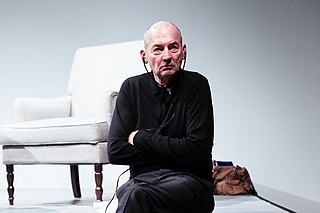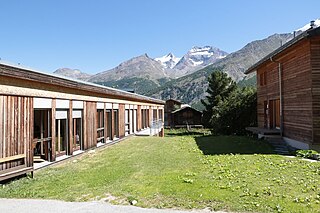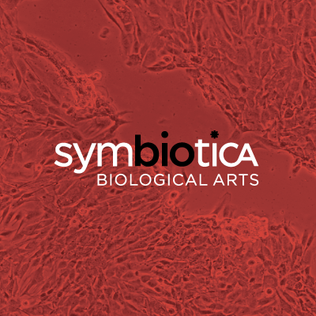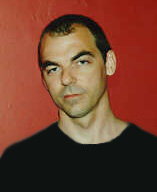
Remment Lucas Koolhaas is a Dutch architect, architectural theorist, urbanist and Professor in Practice of Architecture and Urban Design at the Graduate School of Design at Harvard University. He is often cited as a representative of Deconstructivism and is the author of Delirious New York: A Retroactive Manifesto for Manhattan.

The European Graduate School (EGS) is a private graduate school that operates in two locations: Saas-Fee, Switzerland, and Valletta, Malta.

Electronic art is a form of art that makes use of electronic media. More broadly, it refers to technology and/or electronic media. It is related to information art, new media art, video art, digital art, interactive art, internet art, and electronic music. It is considered an outgrowth of conceptual art and systems art.

The ZKM | Center for Art and Media Karlsruhe, a cultural institution, was founded in 1989 and, since 1997, is located in a former munitions factory in Karlsruhe, Germany. The ZKM organizes special exhibitions and thematic events, conducts research and produces works on the effects of media, digitization, and globalization, and offers public as well as individualized communications and educational programs.

The Serpentine Galleries are two contemporary art galleries in Kensington Gardens, Westminster, Greater London. Recently rebranded to just Serpentine, the organisation is split across Serpentine South, previously known as the Serpentine Gallery, and Serpentine North, previously known as the Sackler Gallery. The gallery spaces are within five minutes' walk of each other, linked by the bridge over the Serpentine Lake from which the galleries get their names. Their exhibitions, architecture, education and public programmes attract up to 1.2 million visitors a year. Admission to both galleries is free. The CEO is Bettina Korek, and the artistic director Hans Ulrich Obrist.

ORLAN is a French multi-media artist who uses sculpture, photography, performance, video, video games, augmented reality, artificial intelligence, and robotics as well as scientific and medical techniques such as surgery and biotechnology to question modern social phenomena. She has said that her art is not body art, but 'carnal art,' which lacks the suffering aspect of body art.

Stelarc is a Cyprus-born Australian performance artist raised in the Melbourne suburb of Sunshine, whose works focus heavily on extending the capabilities of the human body. As such, most of his pieces are centred on his concept that "the human body is obsolete". Until 2007 he held the position of principal research fellow in the Performance Arts Digital Research Unit at Nottingham Trent University in Nottingham, England. He is currently furthering his research at Curtin University in Western Australia.
Hans Kollhoff is a German architect and professor.
Madelon Vriesendorp is a Dutch artist, painter, sculptor and art collector. She was married to Rem Koolhaas and best known as one of the co-founders of the Office of Metropolitan Architecture (OMA) in the early 1970s. Vriesendorp would often create visuals and graphics for OMA in the early years.
BioArt is an art practice where artists work with biology, live tissues, bacteria, living organisms, and life processes. Using scientific processes and practices such as biology and life science practices, microscopy, and biotechnology the artworks are produced in laboratories, galleries, or artists' studios. The scope of BioArt is a range considered by some artists to be strictly limited to "living forms", while other artists include art that uses the imagery of contemporary medicine and biological research, or require that it address a controversy or blind spot posed by the very character of the life sciences.

Virtual art is a term for the virtualization of art, made with the technical media developed at the end of the 1980s. These include human-machine interfaces such as visualization casks, stereoscopic spectacles and screens, digital painting and sculpture, generators of three-dimensional sound, data gloves, data clothes, position sensors, tactile and power feed-back systems, etc. As virtual art covers such a wide array of mediums it is a catch-all term for specific focuses within it. Much contemporary art has become, in Frank Popper's terms, virtualized.

Joseph-Achille Mbembe, is a Cameroonian historian and political theorist who is a research professor in history and politics at the Wits Institute for Social and Economy Research at the University of the Witwatersrand. He is well known for his writings on colonialism and its consequences and is a leading figure in new wave French critical theory.

New media art includes artworks designed and produced by means of electronic media technologies. It comprises virtual art, computer graphics, computer animation, digital art, interactive art, sound art, Internet art, video games, robotics, 3D printing, immersive installation and cyborg art. The term defines itself by the thereby created artwork, which differentiates itself from that deriving from conventional visual arts such as architecture, painting or sculpture.
Afropolitan is a term constructed from the name Africa and the ancient Greek word πολίτης ('politis'), meaning 'citizen'. It is an attempt at redefining African phenomena by, on the one hand, placing emphasis on ordinary citizens' experiences in Africa and, on the other hand, reconceptualizing the African Diaspora's relationship with the African continent. Afropolitanism is used and defined in various ways. The novelist Taiye Selasi and the political theorist Achille Mbembe are immediately associated with the coinage of the term and its fundamental theorization.

SymbioticA is an artistic research lab at the University of Western Australia's School of Anatomy and Human Biology. The lab looks at biology and the life sciences from an artistic point of view and has been used to research, develop and execute a number of contemporary art & science and bioart projects.

Bill Vorn is a Canadian artist, musician and professor known for his robotic artworks. Vorn was also a member of the band Rational Youth from 1981 to 1983.
OkayAfrica is a digital media platform dedicated to African culture, music and politics. Founded in 2011 by Vanessa Wruble and Ginny Suss as a sister site to The Roots frontman Questlove's Okayplayer, the site has become a popular destination for Africans on the continent and in the diaspora. Today, OkayAfrica is the largest US-based website focusing on new and progressive music, art, politics, and culture from the African continent.
Christophe Van Gerrewey is a Belgian architectural and literary theorist, writer and architect. He is currently tenure track professor for architectures, criticism, history and theory at the School of Architecture, Civil and Environmental Engineering (ENAC) of the École Polytechnique Fédérale de Lausanne (EPFL).

Maki Ueda is a Japanese artist. She is currently based in Okinawa and Tokyo, Japan.













